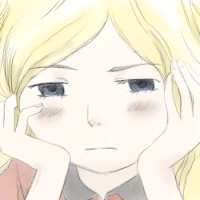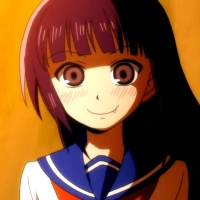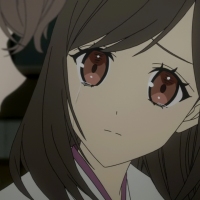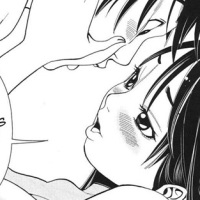“Say it’s only a paper moon
Sailing over a cardboard sea
But it wouldn’t be make believe
If you believed in me.”
-It’s Only a Paper Moon, Harold Arlen
Sometimes, it takes a little magic to make something believable. Sticking glow-in-the-dark stars to your bedroom ceiling won’t suddenly transport you outside, especially with your brother’s snoring. Sledding down the hill behind the elementary school on a stolen cafeteria tray won’t make you an Olympic luge medalist. And the giant plant puppet in the high school play didn’t actually eat your friend playing the sadistic dentist.
Kyoto Animation doesn’t do anything in Tamako Market to make a mysterious tropical talking bird believable to the inhabitants of the Usagi-yama shopping district, he just is. The question that arises is: why?
The obvious answer is to act as a catalyst for the story progression. But why then did they pick a bird that speaks? A loud transfer student, returning childhood friend, or new teacher could have accomplished the same ends. The reason lies in the oddity of Dera Mochimazzi’s existence, allowing him purposefully stand out in the role, where a perceived “ordinary” character would have simply blended in.
Tamako Market focuses on simple problems, but they are no less powerful for being easily identifiable. The Usagi-yama market café becomes the isolated space where characters turn forward and attempt to come to terms with their conflicting, and painfully human, thoughts. In the café, Tamako – the brightest spot in the series – shows a quiet inner strength when speaking of her mother, Midori is able to accept her love for another even if she cannot vocalize it yet, and Shiori is finally able to give a voice to her gratitude.
Much like Chuunibyou Demo Koi ga Shitai! addressed the question of abandoning our childhood dreams in favor of the self-aware mantle of adulthood, Tamako Market displays the personal concerns of its cast by using the exotic bird Dera Mochimazzi as the bridge between inner turmoil and acceptance. He is magical in order to stand out to the viewer, not the characters.
Houtarou’s deductions and Rikka’s delusions are given animated substance in Hyouka and Chuunibyou respectively to show the difference between thought and reality, where Mochimazzi’s existence as the animated magical element of Tamako Market simply is. This allows him to play his part to perfection. He becomes the lens that we peek through into the wonderful world of Usagi-yama. It is Mochimazzi who takes Midori aside and gives her an opportunity to reflect on her love for Tamako in the café. By falling on Shiori – and falling for Shiori – he brings her into the warmth of the shopping district, allowing her to finally speak to Tamako and friends, whom she had always wanted to grow closer to. And although a new transfer student or Usagi-yama shopkeeper could have achieved similar ends, it wouldn’t have been nearly as magical to us, the viewer.
Last year, Mysterious Girlfriend X used magical realism to develop its primary relationship: saliva-tasting and subsequent sharing of emotions were treated as a common occurrence. Like Urabe’s saliva, Mochimazzi’s being is supernatural but also treated as an everyday existence. The truly magical in Tamako Market are the ordinary people who inhabit Usagi-yama, and Tamako herself.
Later on, the series will surely address Mochimazzi’s mission to find a bride for his prince, and the perceived magical elements will come to the forefront, once all of the characters and their relationships have been established. However, I prefer the series as it is now: sticking glow-in-the-dark stars on our ceiling to allow us to appreciate the true beauty of the real night sky.














I agree that the magic of the series can be found in the human characters, which is why I find that bird an unnecesary annoyance and a serious hindrance to enjoying the series.
I think the magic in the series IS the bird. The characters are the realism. We are able to appreciate the realism thanks to the contrast with the magic. Characters are aware of the magic but do not make a big deal out of it; WE make a big deal out of it and that is what takes us down to earth. If Tamako Market didn’t have the bird the story wouldn’t move forward as AJ pointed. It cannot be simply replaced by a human since the fact that it is a bird is important: she can sleep with both Tamako and Mochisuki, fall on Shiori literally, and fall FOR Shiori without influencing the characters. All those are important for the story and I’m sure that as the story reaches its climax, Dera is going to get more and more important.
I agree!
Additionally, I’m morbidly curious as to the bird’s mission and how that will play out within the series. Thanks for the comment. ^ ^
Tzu did a pretty good job below paraphrasing what I said in the article as to the bird being necessary, so while I disagree with you that he is an unneeded annoyance, you bring up a really good point.
If you don’t like the bird, then your enjoyment of this series will be lessened quite a bit, as it sounds like it has been with you.
Personally, I love the bird. He’s *fabulous.*
Thanks for the comment. ^ ^
It makes me wonder if my enjoyment of this show will lessen in the absense of Dera, but that’s different from disliking the bird entirely. It’s hard to tell, I don’t necessarily hate him, and I’d be lying if I said that I didn’t find him charming at all, but he’s just kinda <em<there for me, adding to the charm that’s already there with the other characters.
That said, if you don’t like any character in any work of fiction (and by this I mean not liking the way the character is executed, rather than liking what that character represents), it’s hard to like the work anyway.
Pingback: First impressions of the winter ’13 anime I’m watching — 毎日アニメ夢
Nice ideas about magic and how they relate to Usagi-yama. I agree that it’s going to be the characters and how well they’re fleshed out that will make or break this series. I actually did a small write-up on my site as well! Thanks!
Yeah, I simply love each and every one of the characters in this series. They each bring such a wonderful presence to the shopping district as a whole. Thanks for commenting here. ^ ^
I’m getting the feeling that this sort of thing brushes onto magical realism, as it fits a number of characteristics that are commonly associated with that particular concept. The talking bird is the sole fantastic element in this work, which certainly defies the general laws of reality that we would normally obey. There’s authorial reticence in which the townsfolk simply accept Dera’s existence as commonplace, and thus far, the speaking ability of a bird is not explained within the fictional world, nor is he possibly something that could implicitly exist in real life. Granted, I’m not exactly well-versed on the subject, as there’s a grey area between magical realism and actual Fantasy that encompasses a wide variety of fiction that could arguably fall somewhere between the two; I can imagine magical girl as a whole falling in different places in this spectrum, depending on how the story goes.
That said, whether or not Tamako actually falls within this genre is irrelevant, I feel. It certainly lends well to highlight our collective humanity just as competently as any other work, regardless of whether or not it includes a magical element.
Magical realism is a tricky thing to define for sure (which is why I let bitmap explain the basics for me ^ ^).
I highlight, and applaud, the series’ use of magical realism specifically because it does it so competently. Running parallel to the fantastic element of Dera are also multiple emotional narratives that the series touches upon briefly with the lightest touch that are so heartbreakingly real, which goes to back up your comment on how it doesn’t matter whether Tamako fits neatly into the genre itself.
As an aside, the one I hope they touch upon again is Tamako’s relationship with her mother. Seemingly she remembers her a bit more than Anko, and I wonder if part of her fanatical dedication to mochi-making and Usagi-yama doesn’t stem from the hole left from that loss.
Thank you for your comment. ^ ^
Pingback: Goodbye, Tamako Kitashirakawa. We Hardly Knew Ye. | The Untold Story of Altair & Vega